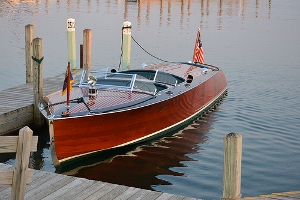Few experiences match watching your reflection in cool water on a hot day while letting your hand drop slowly off of the side as the boat tears itself away from the surface it devours in tumultuous wake. The diesel engine brought freedom and power to rivers, lakes and ocean the world over. The Adirondack visitors’ embrace of motorboats has democratized water leisure but not without taking its own toll on the local environment.
 The first successful motorboat was built in 1888 by the Priestman brothers of Hull, England. It was not until 1908 when John Hacker started his now famous company, Hacker-Craft, that American motor-boating took off (Motorboats). His boats were quickly adopted by the wealthy on Adirondack lakes, where their classic wood strip construction blended beautifully into the natural surroundings (Hackercraft). Later on, the functionality of the diesel engine, which was more efficient and cheaper than previous transports, would appeal to the growing middle-class summer communities that formed after the second world war.
The first successful motorboat was built in 1888 by the Priestman brothers of Hull, England. It was not until 1908 when John Hacker started his now famous company, Hacker-Craft, that American motor-boating took off (Motorboats). His boats were quickly adopted by the wealthy on Adirondack lakes, where their classic wood strip construction blended beautifully into the natural surroundings (Hackercraft). Later on, the functionality of the diesel engine, which was more efficient and cheaper than previous transports, would appeal to the growing middle-class summer communities that formed after the second world war.
Requiring less skill and training to operate, motorboats could be maneuvered easily and safely alone the Adirondack’s crystal lakes by a single family that was no longer dependent on expensive guides or crowded steam liners. So entrenched were motorboats in American and Adirondack culture by the ‘50s and ‘60s that new sports and activities developed that embraced the freedom and adrenaline of the high-powered machines. Despite being invented in the 1920s, water skiing and tubing only became widely popular in the post-war leisure boom. Most lakes in the Adirondacks are long and narrow, and thus perfectly suited to the wants of the tuber and water-skier (Water Skiing).
 Despite motorboats’ apparent centrality to water leisure in the Adirondacks some critics claim it takes a too negative a toll on water health. Calm and scenic Adirondack lakes are often overrun with a variety of privately owned, or rented, motorized watercraft. Of the 100 largest lakes and ponds in the park, only eight are motor-free (Protect the Adirondacks). Apart from the impact of noise pollution, three environmental concerns have led some to call for an expansion of motor-free waterways for the good of the park and its visitors. First, aquatic invasive species are more likely to spread on motor waterways than motor-free. Motorboats are one of the key causes of spreading aquatic invasive species from lake to lake (Protect the Adirondacks). Second, motor-free waters provide better habitats for nesting birds and wildlife. Motorboats disturb these animals that are already in fragile conditions (Protect the Adirondacks). Third, lakes with high levels of motorboat use also experience greater shoreline erosion from increased wake and wave damage on busy day (Protect the Adirondacks). This says nothing of the damage cause by gas and oil on the surface of the water which comes from all motorboats but nothing more so than the jet-ski. In the coming years, these negative environmental impacts and the damage they cause to the tranquility of the park will need to be weighed against the monetary and social value that motorboats bring to the park so that a decision can be made on how best to preserve the waterways for future enjoyment.
Despite motorboats’ apparent centrality to water leisure in the Adirondacks some critics claim it takes a too negative a toll on water health. Calm and scenic Adirondack lakes are often overrun with a variety of privately owned, or rented, motorized watercraft. Of the 100 largest lakes and ponds in the park, only eight are motor-free (Protect the Adirondacks). Apart from the impact of noise pollution, three environmental concerns have led some to call for an expansion of motor-free waterways for the good of the park and its visitors. First, aquatic invasive species are more likely to spread on motor waterways than motor-free. Motorboats are one of the key causes of spreading aquatic invasive species from lake to lake (Protect the Adirondacks). Second, motor-free waters provide better habitats for nesting birds and wildlife. Motorboats disturb these animals that are already in fragile conditions (Protect the Adirondacks). Third, lakes with high levels of motorboat use also experience greater shoreline erosion from increased wake and wave damage on busy day (Protect the Adirondacks). This says nothing of the damage cause by gas and oil on the surface of the water which comes from all motorboats but nothing more so than the jet-ski. In the coming years, these negative environmental impacts and the damage they cause to the tranquility of the park will need to be weighed against the monetary and social value that motorboats bring to the park so that a decision can be made on how best to preserve the waterways for future enjoyment.
Works Cited
“Home” Hackercraft Hacker Boat Company RSS. 6 Nov. 2014. Web. 25 Feb. 2015.
“Motorboat.” Encyclopedia Britannica Online. Encyclopedia Britannica. Web. 25 Feb. 2015.
"The Myth of Quiet, Motor-free Waters in the Adirondack Park." Protect the Adirondacks. May 1, 2013. Accessed April 5, 2015.
"Water Skiing." Adirondack Museum. Adirondack Journal, n.d. Web. 09 May 2015.
